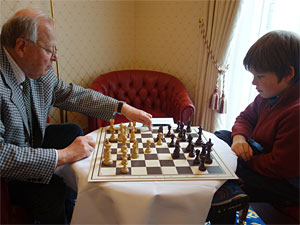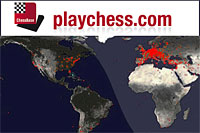
Zurich Legends: A match of equals!
The Zurich Legends match between Viktor Korchnoi and Wolfgang Uhlmann was locked at 1:1 after the first two games. Today the masters played the remaining two games and exchanged blows in them. Korchnoi won the third game with the black pieces and it seemed as if he would win the match. But in the fourth game Uhlmann struck back as Korchnoi blundered a piece. This unique four-game match was thus drawn with a score of 2:2.

Uhlmann came to the board today in a chequered suit
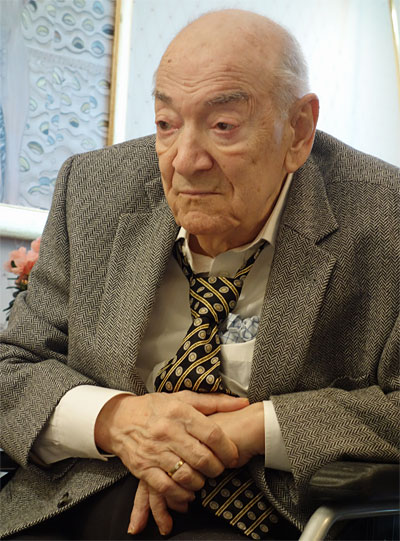
On the surface Korchnoi looks quite frail….
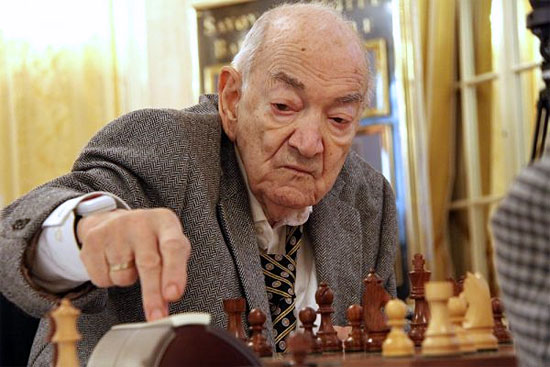
… but when the clocks are started he is nothing but a picture of determination
Before we analyse the games three and four of the match, here is a small piece of statistic for the reader. Apart from being in their eighties, there is something else that binds these two great players: both are such firm adherents of the French Defence, and at some point they were both considered the world’s leading experts in this opening. Out of 862 games in which Korchnoi’s opponents went 1.e4, Viktor Lvovich played the French in no less than 373 games.

Wolfgang Uhlmann’s love for this opening was even deeper: he played the move 1.e6 on as many as 642 occasions out of the 667 games in which his opponents began with 1.e4.
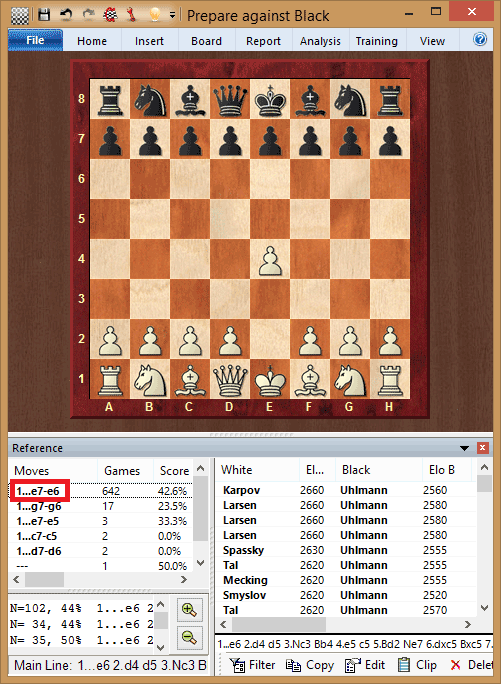
Wolfgang Uhlmann: according to Mega Database a French fanatic!
It’s such a tragedy that we cannot witness this opening being played when the two play each other as neither of them opens the game with 1.e4.
Game three
Uhlmann once again played the English with 1.c4 and built up a nice position out of the opening. Korchnoi managed to equalize after an inaccuracy of his opponent. In the complex middlegame the following position was reached:

Korchnoi’s last move, 25…Be6-g4, was a mistake as Uhlmann could have just snapped off the bishop with 26.Qxg4. After 26…Qxc5 the move 27.Bb2 would have finished off the game. Instead Uhlmann continued with 26. Qg5 and that gave Korchnoi the opportunity to fight back into the game.

After his opponent left him off the hook, Korchnoi played well and without making any further mistakes won the game in 44 moves.
| 1.e4 | 1,185,008 | 54% | 2421 | --- |
| 1.d4 | 959,510 | 55% | 2434 | --- |
| 1.Nf3 | 286,503 | 56% | 2441 | --- |
| 1.c4 | 184,834 | 56% | 2442 | --- |
| 1.g3 | 19,892 | 56% | 2427 | --- |
| 1.b3 | 14,600 | 54% | 2428 | --- |
| 1.f4 | 5,954 | 48% | 2377 | --- |
| 1.Nc3 | 3,911 | 50% | 2384 | --- |
| 1.b4 | 1,791 | 48% | 2379 | --- |
| 1.a3 | 1,250 | 54% | 2406 | --- |
| 1.e3 | 1,081 | 49% | 2409 | --- |
| 1.d3 | 969 | 50% | 2378 | --- |
| 1.g4 | 670 | 46% | 2361 | --- |
| 1.h4 | 466 | 54% | 2382 | --- |
| 1.c3 | 439 | 51% | 2425 | --- |
| 1.h3 | 289 | 56% | 2420 | --- |
| 1.a4 | 118 | 60% | 2461 | --- |
| 1.f3 | 100 | 47% | 2427 | --- |
| 1.Nh3 | 93 | 66% | 2506 | --- |
| 1.Na3 | 47 | 62% | 2476 | --- |
Please, wait...
1.c4 e5 2.Nc3 Nf6 3.Nf3 Nc6 4.g3 d5 5.cxd5 Nxd5 6.Bg2 Nde7!? 6...Nb6 7.0-0 g6 8.b4 a6 8...Nxb4 9.Nxe5± 9.Rb1 Bg7 10.a4 0-0 11.d3 11.b5 axb5 12.axb5 Nd4= 11...Nd4 12.Nd2! c6 13.e3 Ne6 14.Qe2 14.Nc4 Nd5 15.Bb2! Nxb4?! 16.Ba3! 14...Nd5 15.Nxd5 cxd5 16.f4!? 16.Bb2 16...exf4 17.gxf4 Re8 18.Nb3 18.f5 Nd4 18...Qd6 19.Qf3 Qxb4 20.f5 20.Qxd5 Qxa4 20...gxf5 20...Nd8! 21.fxg6 hxg6 22.Qxd5 Bf5 21.Qxf5 Nd8 22.Qxd5 Qxa4 23.Nc5 Qc2 24.Rb6 Be6 24...Bh3!? 25.Bxh3 Re5 26.Qd7 Qxc5 27.Rd6 25.Qh5 Bg4? 26.Qg5 26.Qxg4! Qxc5 27.Bb2! Qxe3+ 28.Kh1 Re5 29.Bxe5 Qxe5 30.Qd7+- 26...Re5 27.Qxg4 Qxc5 28.Rb4 28.Bb2 Qxb6 29.Bxe5 Qxe3+-+ 28...Rg5 29.Qf4 Rg6 30.Re4 Qb5 31.Ba3 Rf6 32.Qh4 Rxf1+ 33.Bxf1 Ne6 34.d4 Qb1 34...Qb3! 35.Bd6 f5-+ 35.Rg4 Kh8 36.d5 Nf8 37.Be7? 37.Qh5∞ 37...Ng6! 38.Rxg6 38.Qg5 h6-+ 38...Qxg6+ 39.Bg2 Rc8 40.Qh3 Rc1+ 41.Kf2 Qc2+ 42.Kf3 Qd1+ 43.Kf4 Rc4+ 44.e4 Qxd5 44...Qxd5 45.Qc8+ Rxc8 46.exd5 0–1
- Start an analysis engine:
- Try maximizing the board:
- Use the four cursor keys to replay the game. Make moves to analyse yourself.
- Press Ctrl-B to rotate the board.
- Drag the split bars between window panes.
- Download&Clip PGN/GIF/FEN/QR Codes. Share the game.
- Games viewed here will automatically be stored in your cloud clipboard (if you are logged in). Use the cloud clipboard also in ChessBase.
- Create an account to access the games cloud.
| Uhlmann,W | 2322 | Korchnoi,V | 2499 | 0–1 | 2015 | A29 | Zurich Chess Challenge 2015 Kortchnoi - | 3.1 |
Please, wait...
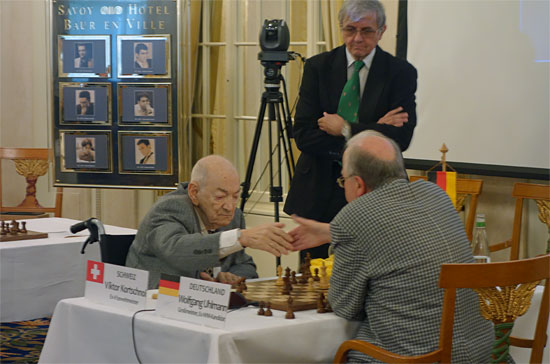
A lead of one point with just one game to go and having the white pieces, Korchnoi definitely was the favourite to win the match. But Uhlmann had some other plans.
Game four
The final game also began with 1.c4 just like the previous three. Soon it transposed into the Maroczy Bind variation of the Accelerated Dragon. With the bishops strongly posted on long diagonals and the weakness of the b5 square, Korchnoi had a firm grip on the position.

Maybe it was tiredness or sheer carelessness which resulted in him incarcerating his bishop on a6 with his move 22.Nb5.
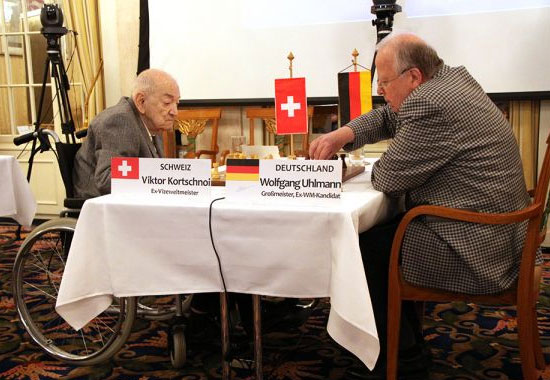
Uhlmann took advantage of this fact and with his powerful move 22…Nb4 and snatched the advantage. Korchnoi did not notice that his bishop was hanging on a6 and dropped the piece after which he promptly resigned.
1.c4 c5 2.Nf3 Nc6 3.d4 cxd4 4.Nxd4 Nf6 5.Nc3 g6 6.Nc2 6.e4 Nxd4 7.Qxd4 d6 6...Bg7 7.e4 0-0 8.Be2 a6 9.0-0 Rb8 10.Re1! d6 11.Bg5 h6 12.Be3 Bd7 13.a4 a5!? 14.c5 dxc5 15.Bxc5 b6 15...Be6 16.Ba3 Be6 17.Bb5! Rc8 18.Rc1 Bb3 19.Qxd8?! 19.Qe2 Bxc2 19...Qc7 20.e5± 20.Qxc2 Nd4 21.Qd3 Nxb5 22.Qxb5± 19...Rfxd8 20.Ne3 e6 20...Nb4! 21.Ba6 Rb8 22.Nb5? Nb4! 23.Rc3? 23.Bxb4 axb4 24.Nc4 Bxa4 23...Bxa4 24.f3 Nxa6 0–1
- Start an analysis engine:
- Try maximizing the board:
- Use the four cursor keys to replay the game. Make moves to analyse yourself.
- Press Ctrl-B to rotate the board.
- Drag the split bars between window panes.
- Download&Clip PGN/GIF/FEN/QR Codes. Share the game.
- Games viewed here will automatically be stored in your cloud clipboard (if you are logged in). Use the cloud clipboard also in ChessBase.
- Create an account to access the games cloud.
| Korchnoi,V | 2499 | Uhlmann,W | 2322 | 0–1 | 2015 | A30 | Zurich Chess Challenge 2015 Kortchnoi - | 4.1 |
Please, wait...
One win each with white and black for both the players the match ended with a score of 2:2.

Relaxing after the match: Wolfgang Uhlmann and wife Christine (foreground), Petra and Viktor Korchnoi
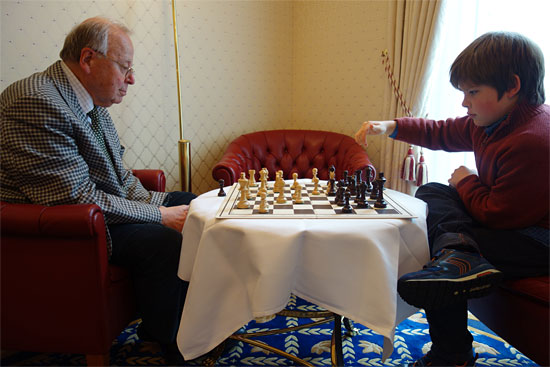
At the final reception we saw the octogenarian grandmaster play an informal game
against an eleven-year-old lad named Anatol who was clearly a very enthusiastic chess fan.

After the game, which Uhlmann won (but not effortlessly), the two analysed for half an hour
together, with the GM explaining strategic principles to the boy, who was clearly eager to learn.
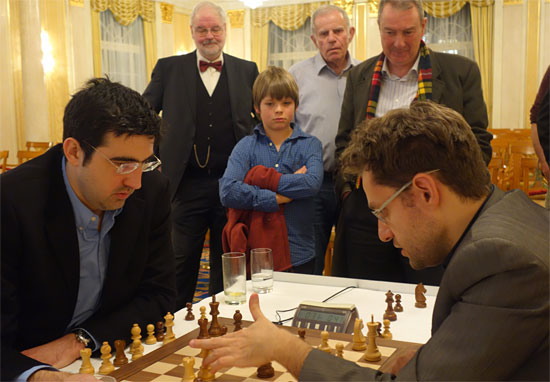
Late the same evening we spotted Anatol keenly following the postmortem of
the round three game between Vladimir Kramnik and Levon Aronian
Anatol, by the way, is a fairly strong amateur, but purely a "hobby" chess player. Here's a little puzzle for our readers: what do you think the lad really excels in? We will tell you the solution in a subsequent report. Be prepared for a big surprise. Hint: some creative googling can reveal his field of brilliance.
The organizers of Zurich must be commended for bringing these two legends of the game back to the chess board. Such matches help us to remember the rich history of chess and also the great heroes of the past.
Pictures by Frederic Friedel and Eteri Kublashvili
Both the legendary players have recorded DVDs for ChessBase.
